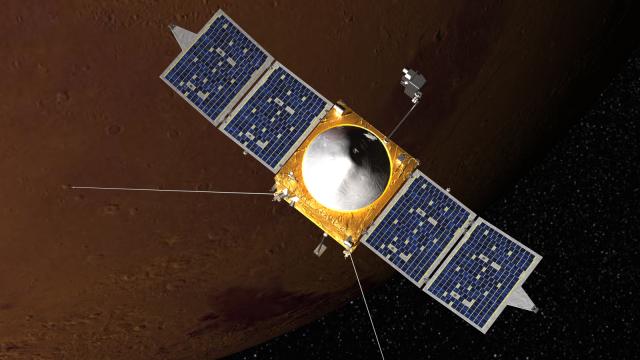We know that Mars once had an Earth-like atmosphere dense enough to support liquid water on the surface of the planet, we’ve found the dry riverbeds and the presence of minerals only formed in water to prove it. We’re also pretty sure that the planet slowly lost that atmosphere into the depths of space on account of climate change. What we don’t know is why. And that’s where NASA’s brand new MAVEN satellite comes in.
From previous observations and experiments, scientists believe that Mars slowly lost 99 per cent of its atmosphere to space due to the planet’s core cooling, which eliminated Mars’ magnetic field. With no magnetic field to shield it, Mars’ atmosphere was eventually stripped away by solar winds.
While we’ve spent billions sending robots to dig in the Martian strata, the MAVEN (Mars Atmosphere and Volatile EvolutioN) mission is the first of its kind — exploring the upper atmosphere of Mars and observing how current solar activity affects the atmosphere. As MAVEN co-investigator Dave Brain, explained to Motherboard:
Think of Mars as a pot of water. You turn the burner on high and and get the pot boiling, and then turn the heat down so the water isn’t actively boiling anymore but there’s still steam coming off the pot. After getting into your mini spacecraft, you fly through the steam taking measurements, and from that data you draw conclusions about the water before it boiled.
The MAVEN itself is built by Lockheed Martin. It measures 11m long, weighs just over 2500kg and draws 1135 watts of power from its pair of massive solar arrays. Scheduled to launch from Cape Canaveral during a 20-day window starting November 18, the MAVEN will take 10 months to reach orbit around the Red Planet and another five weeks to unpack itself, power up and prep for observations. Once ready, the MAVEN will utilise its suite of eight scientific sensors — including a Magnetometer, Imaging Ultraviolet Spectrometer and Solar Wind Ion Analyzer — during the shallow portions of its elliptical orbit (93 miles from the surface) to directly sample the upper atmosphere. During the highest points in its orbit, the MAVEN will snap full-planet ultraviolet images. Every piece of data gathered during the Earth-year-long mission will be sent back to mission control via a twice weekly broadcast from the satellite’s high-gain antenna.
Between the upcoming MAVEN launch and the current ESA Mars Express satellite, Mars won’t have many secrets left — aside from where all the little green men are hiding. [Motherboard – NASA – Wiki – U of CO]
